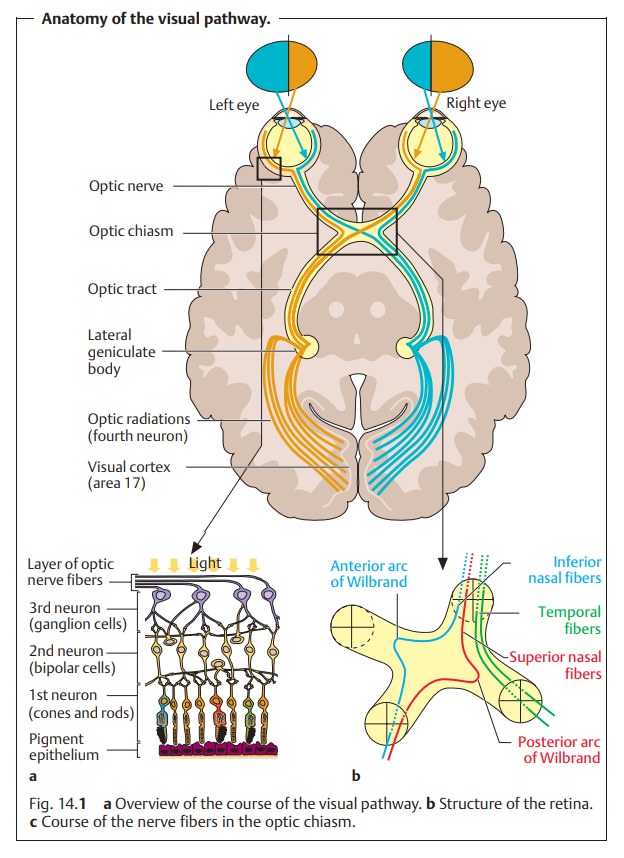Chapter: Ophthalmology: Visual Pathway
Visual Pathway

Visual Pathway
Basic Knowledge
The anatomy of the visual pathway may be
divided into six separate parts (Fig. 14.1):

Optic nerve:
This includes all of the optic nerve fiber
bundles of the eye.
Optic chiasm:
This is where the characteristic crossover of
the nerve fibersof both optic nerves occurs. The central and peripheral fibers from the tem-poral halves of the
retinas do not cross the midline but
continue into the optic tract of the ipsilateral
side. The fibers of the nasal halves
cross the midline and there enter the contralateral
optic tract. Along the way, the inferior nasal fibers travel in a small arc
through the proximal end of the contralateral optic nerve (the anterior arc of
Wilbrand). The superior nasal fibers travel in a small arc through the
ipsilateral optic tract (the posterior arc of Wilbrand).
Optic tract:
This includes all of theipsilateral optic nerve fibers and thosethat cross the midline.
Lateral geniculate body:
The optic tract ends here. The third neuron
con-nects to the fourth here, which is why atrophy of the optic nerve does not
occur in lesions beyond the lateral geniculate body.
Optic radiations (geniculocalcarine tracts):
The fibers of theinferior retinalquadrants pass through
the temporal lobes; those of the superior
quadrants pass through the parietal lobes to the occipital lobe and from
there to the visual cortex.
Primary visual area (striate cortex or Brodmann’s area 17 of the visual cor-tex):
The nerve fibers diverge
within the primary visual area; the macula lutea accounts for most of these
fibers. The macula is represented on the most pos-terior portion of the
occipital lobe. The central and intermediate peripheral regions of the visual
field are represented anteriorly. The temporal crescent of the visual field,
only present unilaterally, is represented farthest anteriorly.
Other connections extend from the visual cortex to associated centers and oculomotor areas (parastriate and peristriate areas). Aside from the optic tract there is also another tract known as the retinohypothalamic tract. This tract is older in evolutionary terms and diverges from the optic chiasm. It transmits light impulses for metabolic and hormonal stimulation to the dien-cephalon and pituitary gland system and influences the circadian rhythm.
Related Topics